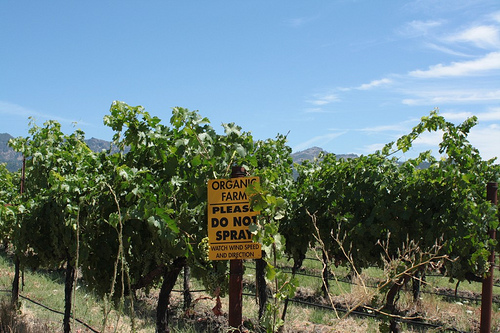
by Colleen Gore
Eating fresh, organic foods can have an enormous impact on your health. You’ll slim down, feel energized, and gain a sense of overall wellness. In addition, there is a peace of mind that comes from knowing you’re not ingesting toxins and chemicals. It’s a great way to help the environment by supporting sustainable farming.
Yet, take a stroll through a natural grocery food store or Whole Foods and peek at the prices. Suddenly, the process of rationalization kicks in and processed foods don’t seem that bad.
There’s no need to sacrifice your health for the sake of your bank account. Wellness needs to be a priority in order to live life to the fullest and ultimately save you money on potential health issues down the road. Here are a few helpful tips to eat organic foods on the cheap:
1. Create a Budget
Create a budget for groceries, just as you would for bills, clothing, and gas. Decide what is a priority and what is not. Would you rather eat healthy or have that new shirt? Instead of hitting up Starbucks on your way to work, invest in some organic coffee to brew at home. You’ll save money and it’s better for you.
2. Buy Organic for Foods with Highest Pesticide Residue
It’s ideal to eat only organic foods. But if you’re really strapped for cash, it isn’t always a reality. At the very least, avoid produce that falls within the Environmental Working Group’s worst offenders for pesticide residue. Always make sure to buy the organic versions of the following:
• Peaches
• Apples
• Sweet Bell Peppers
• Celery
• Nectarines
• Strawberries
• Cherries
• Pears
• Imported Grapes
• Spinach
• Potatoes
• Lettuce
If you’re looking for a place to save, these are the fruits and vegetables the group says have the fewest pesticide residues and are relatively safe:
• Papaya
• Cabbage
• Broccoli
• Kiwi
• Bananas
• Frozen Sweet Peas
• Asparagus
• Mango
• Pineapple
• Frozen Sweet Corn
• Avocado
• Onions
3. Start a Garden
Start a garden and grow your own organic produce. If you’re short on space, find a community garden to join. You’ll always have fresh vegetables and you’ll cut down on produce costs.
Don’t have a green thumb? During warm weather, farmers’ markets are typically abundant. You’ll pay less, support local farmers, and eat fresh.
4. Join a Local Organic Co-op
Look into a local organic co-op. Organic food co-ops often offer organic fruits, vegetables, dairy, and occasionally meat at prices lower than you would find at a supermarket. Co-ops fill boxes with fresh, seasonal food that is either picked-up or delivered. This allows members to obtain fresh food year round.
5. Check Circulars from Grocery Stores
Plan ahead. Check the circulars of your local grocery store, health food shop, or chain, such as Trader Joe’s or Whole Foods. If the establishment doesn’t print circulars, head in early in the week and find out what’s on sale.
Plan a weekly menu, including recipes, around the sale items. Before shopping make a list and stick to it.
6. Buy Store Brand Organic Items
Generic brands are your best friends. Even places like Walmart now carry organic foods. The store brand organic items will always be cheaper than their name-brand counterparts.
7. Find Organic Coupons
Surf the Web for organic coupons. If there are organic brands that you like, visit their Web sites. Most manufacturers offer coupons, particularly if you sign-up for newsletters.
To keep junk mail to a minimum, create an e-mail address that you only use for e-mail from stores and manufacturers. Make sure that you check inside the package as well, as this is where some organic brands house coupons.
8. Buy in Bulk
Buy in bulk and make use of your freezer. Items such as grains can be stored for long periods of time. Therefore, shelf-stable food can be bought in bulk any time.
Organic fruits and vegetables are cheaper when they’re in season. Buy as much as you want and freeze the leftovers. Most produce can be frozen for up to six months.
9. Start a Buying Club
Round up fellow healthy eaters and start your own buying club. Ask co-op grocers and health food stores where they get their products. Call the manufacturer and see if they are willing to let you buy in bulk.
Most are open to the arrangement as long as you meet the minimum order requirements. You’ll receive a huge discount and you merely have to divvy up the spoils among members.
10. Go Meatless Few Days a Week
Opt for a few meatless days per week. Meat is costly and much of it is imported. When a recipe calls for meat, use beans instead. It will still be tasty, yet cheaper and healthier.
11. Buy Organic Canned Items
During the winter when most produce is imported, the prices skyrocket. Though fresh food is best, organic canned options, such as diced tomatoes, flash frozen organic vegetables, and dried organic fruits can do in a pinch. Just be sure to purchase BPA-free cans and if possible, food that’s packaged in glass jars.
Remember these pointers the next time you stock up on organic groceries. Experiment with different recipes until you find ones that are healthy, appetizing, and cost-effective. If you have a few go-to meals in your arsenal, you’ll be able to tailor the ingredients to suit your budget. Saving money on organic food doesn’t mean sacrificing quality, instead it’s about shopping smart.
(Colleen writes the Healthy Diets section at dietplansweekly.com. She is also a yoga teacher, freelance writer, and health fanatic.)






Be the first to comment